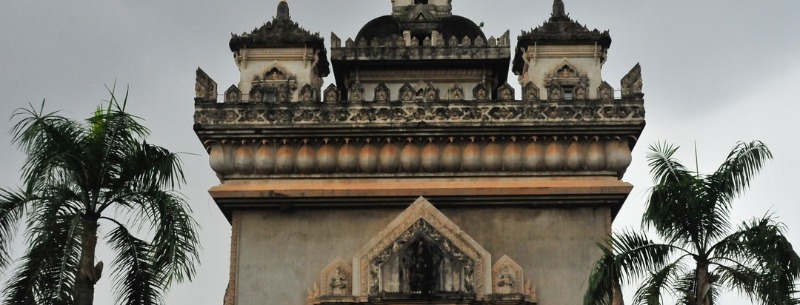Vientiane, capital city of Laos
Delightfully friendly and abundantly beautiful, Vientiane is somewhere between a diminutive city and a large town. Crumbling French mansions sit next to steaming noodle stalls, the streets are lined with colorful bougainvillea blossoms and the morning market greets each day with bustling energy. The evolving city is full of charms, and you will find yourself quickly won over by its unusual sights, excellent food, and kind people.
The most prominent monument in the capital is the Patuxai, reminiscent of Paris’ Arc de Triomphe. Even more magnificent than its French counterpart, the Laotian version has four archways instead of a measly two. Built in the 1960s, the elegant arch welcomes visitors to the city and is a symbol of Vientiane.
Near the center of the city is That Dam, a stupa that, according to local legend, was once coated in pure gold. Rumor has it that the Siamese stripped the gold during their raid in 1828, and the stupa remains black in memory of the act. Other legends dictate that the stupa is the home of a sleeping seven-headed dragon that protects the local citizens. Whatever you believe, That Dam is a must-see sight for its astounding beauty and graceful design.
Laos is a predominantly Buddhist country, and Pha That Luang is a symbol of both the faith and the country’s sovereignty. If it looks familiar, that is because the stupa is on the national seal and other official places. Legend tells that the stupa contains the breastbone of the Buddha, placed there when it was built by Ashokan missionaries from India in the 3rd century BC.
Wat Sok Pa Luang lacks the legendary background of other sights, but the temple is famous for its expert massage and herbal saunas. After relaxing your worries away in the sauna, enjoy an herbal tea on the veranda, surrounded by lush flowers and singing birds.
One of the most important temples in all of Laos is the Wat Ong Teu Mahawihan. Built in the mid-16th century, the temple grounds have been used for religious purposes since the 3rd century. A huge bronze Buddha statue dominates the ordination hall, giving the temple its name, which means “Temple of the Heavy Buddha.” It is also beloved for its elaborately carved wooden facade.
If you need a break from the temples, visit the Lao National Museum. The slightly haphazard museum includes everything from Hindu sandstone sculptures and dinosaur bones to firearms, the chairs of national heroes and old photographs of Pathet Lao soldiers. The ethnographic section is a mix of pots, drums and tools, and the second floor is filled with relics from the French colonial period and the country’s liberation.
Across the street from the National Museum is the Lao National Culture Hall, housed in an eye-catching building adorned with ornate gold trim and soaring columns. Gifted to the people of Laos in the late 1990s by the Chinese, the center is only open during scheduled cultural events, but classical dance performances, French films and beauty pageants are held regularly.
Vientiane Geographical Location
Vientiane is located on the Mekong River in the central west of Laos, next to Thailand’s border.
Vientiane is the largest city in Lao with a population of approximately 755,000.
Vientiane Language
Lao is the official language in Laos but French, English, and various ethnic languages can also be found throughout the country.
Vientiane Predominant Religion
- 67% Buddhist
- 31.5% Other
- 1.5% Christian
The majority of Christians live in Vientiane while the Buddhist population commonly practices animism additionally.
Vientiane Currency
The Kip is the official currency of Laos.
Vientiane Climate
It is typically hot and humid in Vientiane with a monsoon season between April and October.
Vientiane Main Attractions
- Buddha Park
- Wat Si Saket
- Patuxai
Other Attraction in Vientiane
- Great Sacred Stupa
- Lao National History Museum
- Black Stupa
- Cooperative Orthotic and Prosthetic Enterprise
